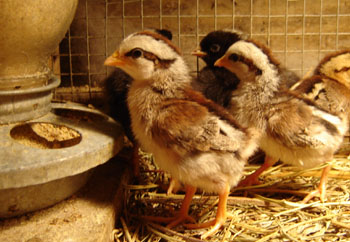 | How
Long Does Hatching Take
Hatching
can take place over several days. For chickens, run the incubator for 24 days
(3 days more than normal hatch time). For ducks and turkeys run the incubator
for 32 days (4 days more than normal hatch time).
It is better not to
help a chick/duckling/poult crack out of its shell. If you do, they almost always
die (unless you follow the instructions in the next paragraphs).
|
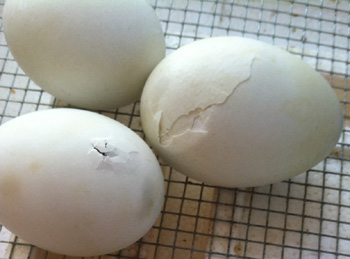 |
First Pip
to Unzip to Out of Shell
It is usually 12-18 hours from pipping (first hole in egg) to hatching,
though it can take up to 48 hours. It is called unzipping when the baby
chips at the egg in a circle.
"I stopped
turning my Ancona duck eggs at day 25. One of the backwards babies (head
down) couldn't break through the shell and suffocated before I could save
him. I didn't see him trying to pip in time since he was was pipping from
the bottom." -Betsy, Indian Trail, North Carolina
|
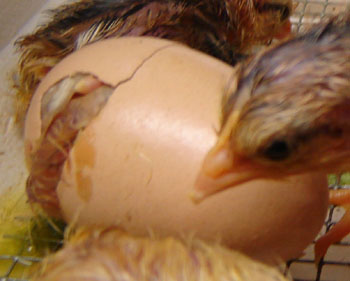 | How
to Help Baby Poultry Get Out of Shell Once Pipping Starts
When a baby becomes too large to get oxygen through the egg shell pores, it
uses its egg tooth to make a hole in the air sac at the flat, fat end of the egg.
The egg tooth falls off a few days after hatching.
Pipping is when chicks,
ducklings or poults start pecking on their shell so they can get out. They peck
in a circle so the egg falls apart in half or so.
The egg to the left
is a chicken egg. You can see the beak at the top of the hole.
|
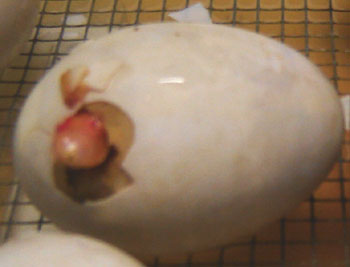
 |
Keep
Hatching Humidity High
Inside the shell are 2 membranes. The inner membrane controls blood flow to the
chick/duckling/poult, and the outer membrane holds moisture. The chick breaks
the shell slowly and controls the stopping of the blood flow.
It can
take 12 hours or more for the baby to come out of the eggshell once it first puts
a little crack in the egg. It usually only takes an hour or so.
Make
sure humidity is high during hatching. You may need to spray eggs with a little
water. Only open incubator when absolutely necessary to keep in moisture.
The eggs to the left are duck eggs.
"When I was helping them out of the shell and cut into the membrane to get them started on coming out, they would start to bleed a little. I would wrap them partially in a damp paper towel and just let them sit for a couple hours in the incubator.
The dampness raised the humidity so high that fluid started building up in the eggs close to their yolks. One died within minutes of wrapping it and another several hours after helping it. In fact we almost had the last one in a position to come out.
Through this experience what I learned is to stop the blood flow like you would with any wound we would get: by applying pressure with a dry paper towel." -Rachel, Louisville, Kentucky
|
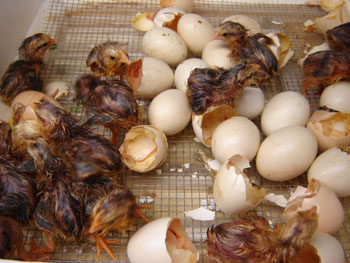 | Stay
Warm and Be Patient
If you do want to help a hatch that has already started (chick/duckling/poult
has made a small hole in egg), then take egg out of incubator and go to a warm
place. With dull tweezers, remove a little bit of the egg shell around the hole.
Do not remove any of the inner membrane. Do this in a circle around the shell
like the baby would do it. Put the shell in the tweezer and pinch off small pieces.
|
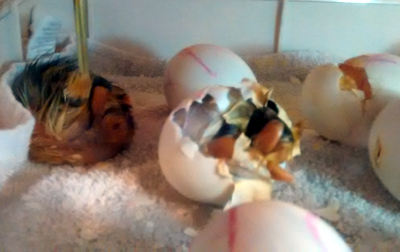 |
Make
Sure Baby Can Breathe
"Just
wanted to tell you 9 out of 10 Ancona duck eggs you sent me are fertile
and forming... yeaaaaa.. thank you so much.. Hope the rest of their growing
time goes well... So excited." -Vicki, Bloomington, Wisconsin
"The
baby in the picture on the right half in shell was breach. Poor baby tried
and tried to get out of shell. His/her legs were above its head and wing
half over face. He pipped a hole, and I could see his poor little beak quivering.
I helped him/her every little bit to keep membrane moist and the air hole
open. I could hear it crying in shell. After about 16 or 17 hours it was
free!" -Vicki, Bloomington, Wisconsin
|
 | Keep
Egg Moist
While you are doing this, keep the egg membrane moist with warm water in a dropper.
The key to this is keeping the membrane moist.
Do not drown baby. If you see blood,
stop.
After cracking around some or all of the egg, wrap a warm, very
wet piece of washcloth around the cracked parts of the egg. Do not cover the beak.
Put back in incubator. The beak should be on its side or facing up.
|
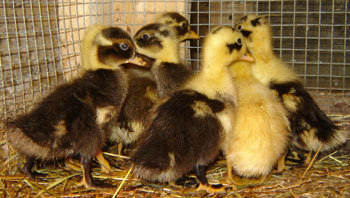 | When
to Remove Babies from Incubator
Remove chicks, poults or ducklings from the incubator once a day. They can live
for 48 hours without food or water. You only remove once a day so the incubator
maintains stable temperature and humidity.
Some incubators have a small
plug you can remove to help reduce humidity while babies dry.
|








